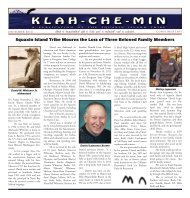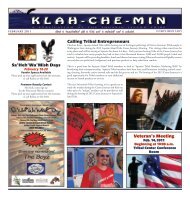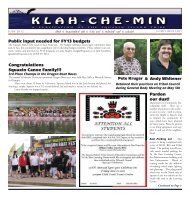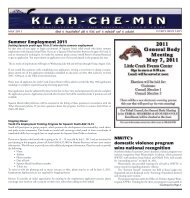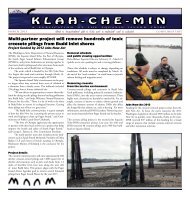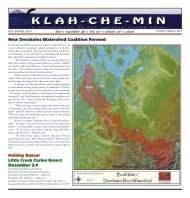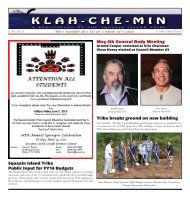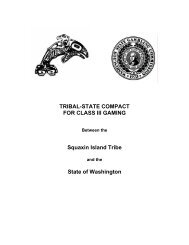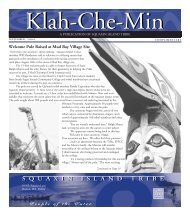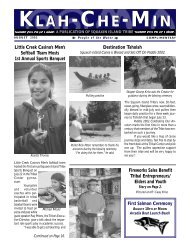You also want an ePaper? Increase the reach of your titles
YUMPU automatically turns print PDFs into web optimized ePapers that Google loves.
Community<br />
NOAA Sea Grants<br />
NOAA provides Sea Grants starting at $800,000. that could potentially be applied to<br />
starting up a fish coop (http://www.seagrant.noaa.gov).<br />
USDA<br />
Funding is available for feasibility studies, working capital and guaranteed loans. According<br />
to USDA representatives, there are 29,000 co-ops in the U.S., producing a gross<br />
$652 billion a year, $152 billion in income, and 2.1 million jobs.<br />
Commodity Foods Program<br />
The USDA Commodity Foods program has a mandate to supply traditional native foods.<br />
Intertribal Agriculture Council<br />
American Indian Foods: The Intertribal Agriculture Council (IAC) promotes the "Made<br />
by American Indians" trademark as a means to successfully and clearly identify actual<br />
American Indian products from federally recognized <strong>Tribe</strong>s. In January 1995 the United<br />
States Patent and Trademark Office finally approved the trademark. IAC currently has<br />
over 500 licensed trademark users. Producer as well as consumer interest continues to<br />
grow and offers improved marketing potential for all Indian producers through national<br />
and international exposure. The IAC's booklet on use of the "Made by American Indians"<br />
trademark offers an overview of the uses of the trademark as well as an application<br />
for its use. More information is available through the NW Agriculture Business Center<br />
(www.agbizcenter.org).<br />
This organization (http://indianaglink.com/americanfoods.html) has funds available to<br />
send representatives to international trade shows, to provide assistance with bar codes,<br />
and to develop food packing stamps, such as branding a "Pacific Northwest Native<br />
Caught" label with an option to add each tribe's own logo (this is currently being coordinated<br />
by Norm Nault, former <strong>Island</strong> Enterprises Director, and current Executive<br />
Director for Consultants for Indian Progress).<br />
Problems<br />
Marketing. People don't know when they're buying and eating Pacific NW Native<br />
caught salmon. They don't understand the difference.<br />
Runs size & timing. Runs differ from year to year, from tribe to tribe, in both size and<br />
timing. If there is not enough fish to fill the pipeline, trust will be lost.<br />
Proper handling. In order to create and maintain an effective market, fish need to be<br />
carefully handled and chilled. Many tribal fishers lack adequate training and equipment.<br />
Competition/Collaboration. Fishers are competitive, and don't want to work together.<br />
A co-op method requires a change of attitude to be able to work together cooperatively.<br />
Even fish commissions fight each other.<br />
Distribution. Tribal fishers don't have time market their own catches, or to run fish to<br />
buyers and processing facilities.<br />
Solutions<br />
Solutions suggested at the Native Fishers Cooperative Workshop included:<br />
"We want high-end markets, buying our high-grade fish, to move the prices up, and then<br />
expand to volume," a workshop attendee said.<br />
Chinook, the prime salmon, make up .5% of the market. We need to target chinook to<br />
create high-end markets.<br />
An intertribal co-op could better manage run sizes and timing, ensuring salmon are available<br />
for long periods of time, thus maintaining the market. If one tribe is having a bad<br />
year, another might be doing great. We need small solutions for times when run sizes are<br />
low and large facilities don't want to deal with small catches. But we also need solutions<br />
for processing massive amounts of fish when runs are good. Combining efforts benefits<br />
all, ensuring a steady supply by coordinating run times and sizes.<br />
"I propose, not a co-op, necessarily, but a marketing association, something that creates<br />
a buying network," a fisher from Tulalip said.<br />
The Swinomish Fish Company processes fish for other tribes at a significantly reduced<br />
rate. It can produce 11 tons of ice per day, with its $140k ice machine. Tribal fishers can<br />
process fish through Swinomish and sell to their own casinos and restaurants. Currently,<br />
all tribal casinos and restaurants have buffets and serve seafood, but they don't serve their<br />
own fish.<br />
The Muckleshoot <strong>Tribe</strong> has secured a contract with Safeway.<br />
We need to establish a tribal sustainability certification program.<br />
We need to brand "Pacific Northwest Native Caught" FDA approved and sustainability<br />
certified, with room for specific tribal logos. This branding should include the "Made<br />
by American Indians" trademark and should have a story to tell/sell. Everybody knows<br />
Copper River salmon. This is a good example of a successful marketing plan.<br />
Pressure commissions to work together.<br />
Provide tribal fishers with training on proper handling techniques and equipment.<br />
Form a limited liability corporation, (LLC) that is independent from tribal governments.<br />
Utilize government programs that are in place to assist us.<br />
There are an estimated 16.5 million pounds of salmon being fished from Pacific Northwest<br />
waters along the coast to Alaska each year. With tribal fisheries guaranteed a 50%<br />
share, a hugely generalized estimate would put the tribal share at more than 8 million<br />
pounds per year.<br />
Why not form co-ops of tribal fishers who sell through a coop of member tribes, who<br />
market, distribute and process through one (or more) central location(s) (possibly Swinomish)?<br />
We have all kinds of intertribal organizations. Why not this one? Lets join<br />
the big leagues and drive the market ourselves! "I foresee tribes running the show in the<br />
future," an ATNI representative said.<br />
S q u a x i n I s l a n d T r i b e - K l a h - C h e - M i n N e w s l e t t e r - M a r c h 2 0 1 2 - P a g e 3




